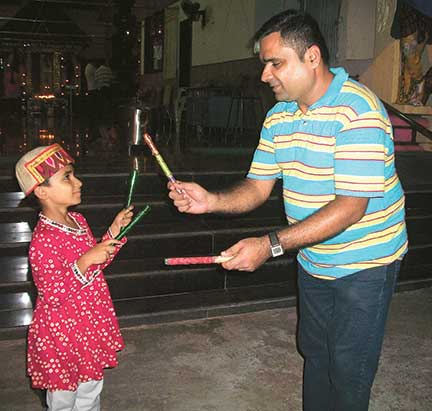Sonia Kapoor
Last year during Dasara, I enjoyed being a passive observer of a wonderful incident that involved my four-year old son, Ayaan. My residential colony consists of young adults, college students, and very few kids (my son belongs to this minority group).
Being an enthusiastic mother, I dressed up Ayaan in a bright dandiya outfit and took him for the dandiya raas. The dancers had formed two concentric circles to play dandiya and it was a heterogenous group. Using his flexible body Ayaan wriggled his way into one of the circles. But could he match and synchronize his dance steps with those of the others?
No. In fact, at times he would hit the dandiya on the fingers of other dancers. I was a bundle of nerves and thought that I may soon get annoying stares from the dandiya lovers for the inconvenience they were facing because of Ayaan. But, to my surprise I saw that he was being accommodated well. Everyone would slow down their pace, bend down to gently tap his dandiya before moving ahead at their original speed.
I was touched and being a teacher, the first thought that came to my mind was that this was an apt example of inclusion, albeit, social inclusion. Inclusion is still in the nascent stage in most Indian schools and educationists are working hard to successfully implement it.
 This incident brought a permanent change in my approach towards the students in my classroom. Instead of Why, I now focus on – What if my own child was in a situation like this? What would I have expected from the system? I am working towards a single goal – I want to be an inclusive educator. For this, there is no special B.Ed. Yes, there are courses for becoming a Special Educator but to become an Inclusive Educator, one has to strive hard and inculcate a desire to cater to the needs of a diverse range of learners in collaboration with parents, learners, administrators and most importantly fellow teachers.
This incident brought a permanent change in my approach towards the students in my classroom. Instead of Why, I now focus on – What if my own child was in a situation like this? What would I have expected from the system? I am working towards a single goal – I want to be an inclusive educator. For this, there is no special B.Ed. Yes, there are courses for becoming a Special Educator but to become an Inclusive Educator, one has to strive hard and inculcate a desire to cater to the needs of a diverse range of learners in collaboration with parents, learners, administrators and most importantly fellow teachers.
Broadly speaking, inclusive education for an ordinary teacher implies all learners, with or without difficulty, being able to learn together as per their potential. It celebrates diversity and follows the philosophy of addressing the individual needs of all the students. Inclusion is not just for differently abled, it’s for all the learners as each one is unique with different needs.
As an inclusive educator, I have realized that restructuring teaching strategies in response to student needs is inevitable. A multi-sensory approach, computer-aided instruction, using teaching aids along with a wide range of constructive activities especially with the primary section kids are very helpful. Various workshops and orientation programmes have been immensely helpful in my journey as an inclusive educator.
Ideally in a regular class, in addition to the so-called “normal students”, we come across students with learning difficulties, Autism Spectrum Disorder, Speech or Hearing Disorder, slow learners and sometimes even children with some physical handicap. In order to ensure a non-discriminatory climate in the classroom, an inclusive educator has to think differently, plan activities pragmatically and act patiently.
Simple things like colour coding (for example – receive), identifying the type of learner (visual, auditory or kinesthetic) and in every teaching-learning session trying to incorporate an activity that caters to each of these, giving short breaks that involve stretching and simple movements that can be done in their respective seats, devising a variety of assessment tools to provide opportunities to the learners to express themselves in some way – these have really helped in handling the heterogenous set of children. In the case of some students, the prime objective before academics has been their social and emotional compatibility with the other students. Here, counselling of other students, their acceptance of the situation and willingness to co-operate is crucial. In fact, I ought to mention that the limited class strength of around 35 students per class in our AEES schools greatly facilitates and supports my effort. Also, I have realized that this goal of inclusion has actually improved my skills as a teacher.
And the most important lesson that I’ve learnt is that – Inclusion is not just an approach restricted to school education, it is a way of life!
The author works with Atomic Energy Central School, Mumbai, and is keenly interested in inclusive education. She can be reached at soniakapoor2108@gmail.com.
